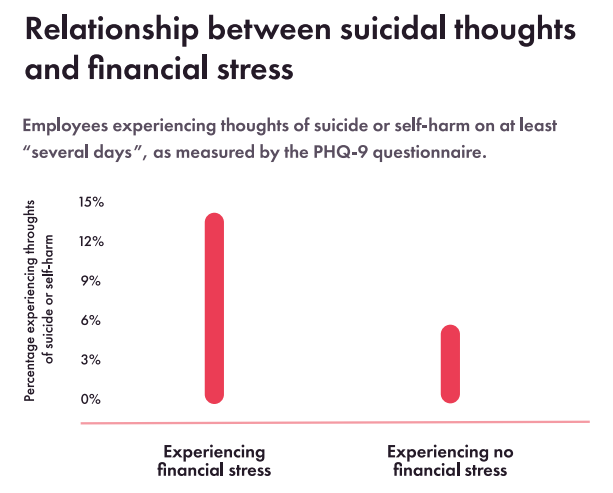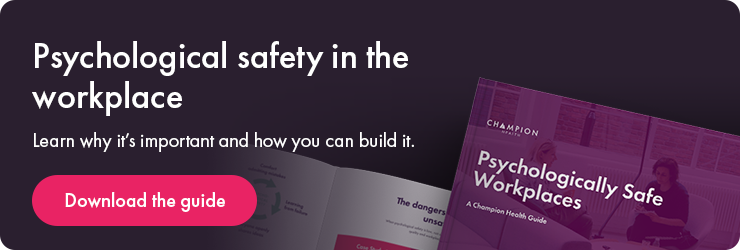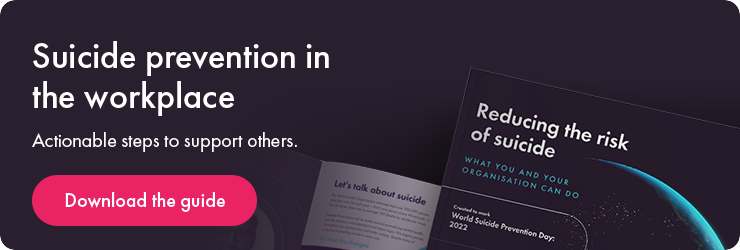Most of us spend the majority of our waking hours at work. Therefore, suicide prevention at work has a huge role to play in suicide prevention generally.
According to the World Health Organisation, almost 1 million people die from suicide, every year. For every person who dies from suicide, twenty more make an attempt. Each one is a preventable tragedy – an unanswered cry for help.
The highest rates of suicide occur during our working lives – peaking in the late 40’s. Sadly, suicide is also the fourth leading cause of death among 15–19-year-olds, which means people who are just starting out on their working lives are amongst those at highest risk.
Therefore, workplaces play a critical role in suicide prevention.
In this article, we’ll explore what suicide prevention at work means in practice and the actionable steps employers can take to reduce the risk of suicide.
Create a culture of care
For suicide prevention at work to be effective, every worker needs to know someone, in their workplace, who will listen to them, without judgement, at a time of distress.
For this to be a realistic possibility, an organisational culture of care is essential. This is a culture where leaders genuinely care about the health and wellbeing of every employee.
Your workplace must be a psychologically safe working environment, where:
- It’s okay (and encouraged) to speak up
- A listening ear is always there for struggling employees
- Accessible support and signposting are in place to prevent suicide.
It’s also important that employers recognise how work-related factors may also contribute to suicidal thoughts.
For example, Champion Health’s research revealed that employees experiencing financial stress were twice as likely to experience thoughts of suicide or self-harm.

An issue or combination of other work-related issues – such as job insecurity, discrimination, work stressors and bullying – may also play a part and need tackling at source.
Support your line managers
The responsibility to lend a listening ear often falls on your line managers – so make sure they’re prepared. Encourage each line manager to notice subtle changes in a team member’s behaviour that signal all is not well.
Read this article to learn about the common signs to look out for: How to spot mental health issues at work
If a line manager spots any of these signals, it’s time to start the conversation.
Simple conversation-starters like these may just save a life:
- How are you? No really, how are you?
- You don’t quite look yourself today – do you want to have a coffee?
Watch this video to discover more ways to bring up mental health with a colleague or team member:
Of course, your managers need support too. Their role is not to take the weight of individual responsibility on their own shoulders alone. Instead, if a struggling employee approaches them, they just need to know:
- What to do in the moment
- What to say
- How to offer support, without seeming to just signpost without empathy
In many cases, equipping your line managers with these essentials will require training.
It’s also crucial to dispel the myths that may cause a manger to hold back. A good example is the myth that talking about suicide may give someone the idea.
In fact, the opposite is true – bringing up the subject of suicide and discussing it may just save a life. It is one of the most helpful things you can do.
Coordinate peer support
Everyone can play a role in suicide prevention at work. The listener for struggling employees doesn’t have to be the line manager – it could also be a peer-support worker.
Sadly, many of us have had direct or indirect experiences of suicide with friends, family or co-workers. Therefore many of us are motivated to help others to avoid the tragedy of suicide.
Given the opportunity, many of your employees will be only too happy to volunteer to help – so give them that opportunity.
Coordinate peer support and make it known who is available to listen. Just as with managers, the first responder to a mental health issue will need support and training.
They are not therapists, so they also need to know how to guide a distressed person to expert help and where the boundaries between supporter and therapist lie.
Champion Health have created a simple 5-step process, which every employee can follow to support struggling colleagues. Discover that process here: The CLASS Approach: How to Support Others
Communication, communication, communication
Whatever the form of support that your organisation puts in place, there are three essentials for suicide prevention at work to be a success: communication, communication, communication.
Firstly, every employee needs to know who and where they can turn to at a time of distress. Campaigns around the mental health support you have available will help with this.
Secondly, every employee needs to believe that they will be able find someone who can help them. Hearing from others – especially leaders – who have been helped through difficult times will be effective for this.
Thirdly, your employees need to know that if they reach out for support, they can trust that someone at the other end of the conversation. This comes back to that consistent culture of care being present in an organisation from the top down.






